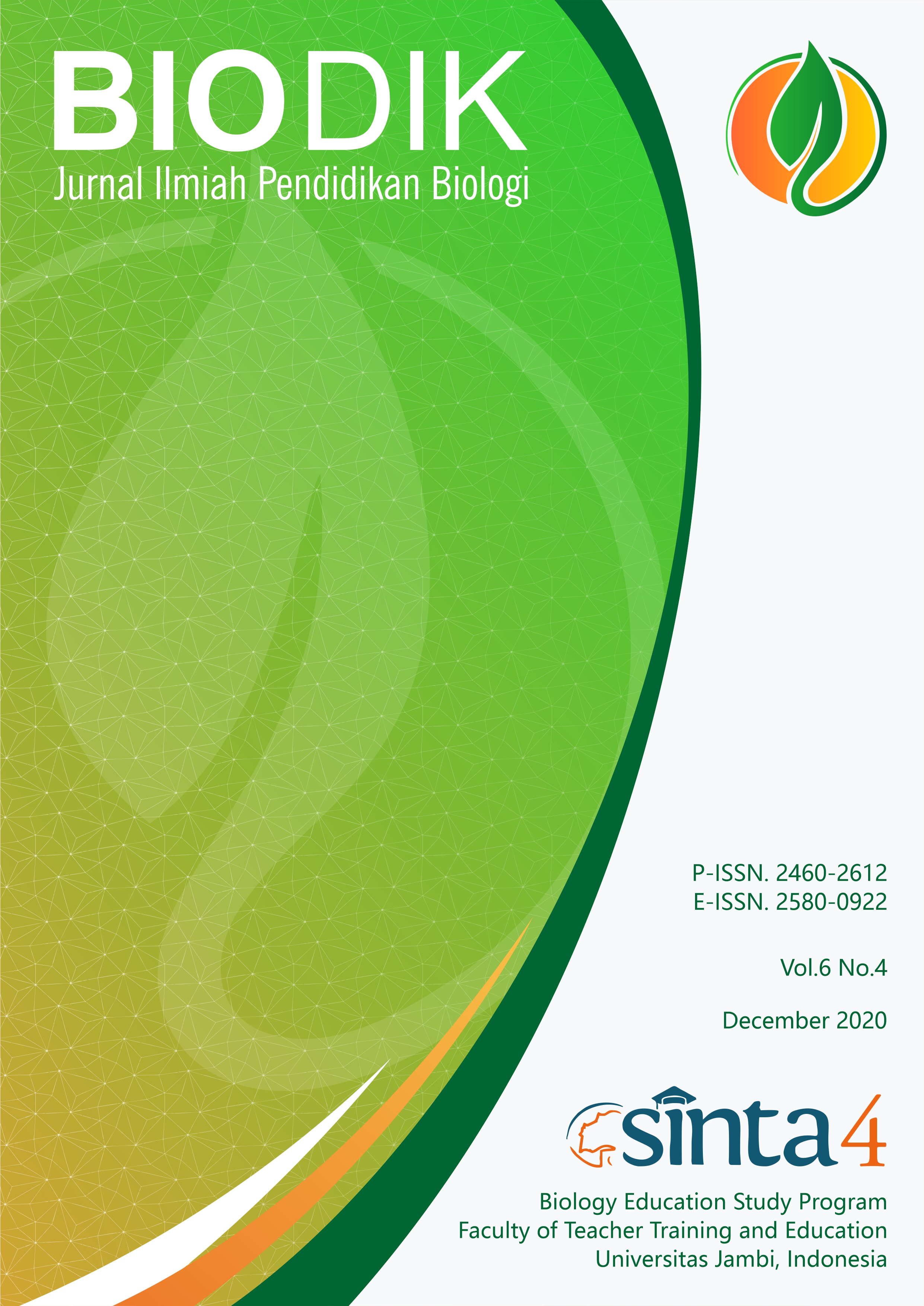Analisis Relevansi Materi Superkelas Pisces dalam Aspek Penerapan Ilmu Taksonomi Hewan di Sekolah
(Analysis of the Relevance of Pisces Superclass Material in the Aspect of Application Animal Taxonomy in Schools)
DOI:
https://doi.org/10.22437/bio.v6i4.10964Abstract
The science of taxonomy animal is a science that is constantly experiencing growth. One of the objects of study of the taxonomy of animals is a superclass Pisces that its application is also done at the school through the teaching of biology. To expand the repertoire of science knowledge regarding Pisces, not be separated from research that are continuously being developed by experts to produce discoveries about the Pisces superclass which also have an impact on the discovery of new concepts. Will but the content material superclass Pisces on learning and several book packages that use has not been demonstrated progress hot, even still finding misconception. This is certainly not appropriate if it is still implemented. Through the articles of this author will give a review of the science regarding the reason for the importance of increasing the relevance of the content material to expose the data and facts state of content material superclass Pisces during this. Articles of this come through research by using approach qualitative type of study library (library research).
Abstrak. Ilmu taksonomi hewan merupakan ilmu yang senantiasa mengalami perkembangan. Salah satu objek kajian taksonomi hewan adalah superkelas pisces yang penerapannya juga dilakukan di sekolah melalui pembelajaran biologi. Untuk memperluas khasanah ilmu pengetahuan mengenai pisces, tidak akan lepas dari penelitian-penelitian yang terus dikembangkan oleh para ahli untuk menghasilkan penemuan-penemuan baru tentang superkelas pisces yang juga berdampak kepada penemuan konsep-konsep baru. Akan tetapi konten materi superkelas pisces pada pembelajaran dan beberapa buku paket yang digunakan belum menunjukkan perkembangan terkini, bahkan masih ditemukannya miskonsepsi. Hal ini tentu tidak tepat jika masih diterapkan. Melalui artikel ini penulis akan memberikan kajian ilmiah mengenai alasan pentingnya meningkatkan relevansi konten materi dengan memaparkan data dan fakta keadaan konten materi superkelas pisces selama ini. Artikel ini hadir melalui penelitian dengan menggunakan pendekatan kualitatif tipe studi pustaka (library research).
Downloads
References
Budi, B. (2019). Dimensi Pembaharuan Dalam Peningkatan Mutu Pendidikan. Hijri, 8(2), 38–53.
Dahar, R. . (2011). Teori- Teori Belajar. Jakarta: Erlangga.
Destiara, M. (2020). Efektifitas Bahan Ajar Berbasis Potensi Lokal Pada Materi Pisces terhadap Hasil Belajar. Bioeduca: Jurnal Pendidikan Biologi, 2(2), 7–12.
Fernandes, R. (2019). Relevansi Kurikulum 2013 dengan kebutuhan Peserta didik di Era Revolusi 4.0. Jurnal Socius: Jorunal of Sociology Research and Education, 6(2), 70–80. https://doi.org/https://doi.org/10.24036/scs.v6i2.157
Gafur, A. (2003). Penerapan konsep dan prinsip pembelajaran kontekstual (Contextual Teaching and Learning) dan Desain Pesan dalam Pembelajaran dan Bahan ajar. Cakrawala Pendidikan, 22(3), 273-289
Indrawati, P. (2017). Pengembangan LKS Pengamatan dengan Pendekatan Saintifik (5M) pada Materi Superkelas Pisces untuk Pembelajaran Biologi Kelas X. BioEdu, 5(2), 19–34.
Johanson, Z., Manzanares, E., Underwood, C., Clark, B., Fernandez, V., & Smith, M. (2020). Evolution of the Dentition in Holocephalans (Chondrichthyes) Through Tissue Disparity. Integrative and Comparative Biology, 60(3), 630–643.
Keidel, L., GarcÃa-Varela, M., Brener, B., de León, G. P. P., & Santos, C. P. (2019). Integrative taxonomy reveals a new species of Dollfusentis (Acanthocephala: Illiosentidae), in Orthopristis ruber (Osteichthyes: Haemulidae) from Rio de Janeiro, Brazil. Parasitology International, 71(1), 132–142.
Masturah, H., Hutabarat, S., & Hartoko, A. (2014). Analisa Variabel Oseanografi Data Modis Terhadap Sebaran Temporal Tenggiri (Scomberomorus commersoni, lacepede 1800) di Sekitar Selat Karimata. Journal of Management of Aquatic Resources, 3(4), 11–19.
Ormrod, J. . (2009). Psikologi Pendidikan Membantu Sisiwa Tumbuh dan Berkembang Jilid I. Jakarta: Erlangga.
Pratomo, H., & Rosadi, B. (2010). Identifikasi Pisces. Jakarta: Universitas Terbuka.
Prawara, A. S., Johan, A., & Jusup, I. (2018). Pengaruh Pemberian Vitamin C Terhadap Kadar Glutation (GSH) Tikus Sprague Dawley yang Terpapar Heat Stress. Jurnal Kedokteran Diponegoro, 7(1), 39–48.
Razak, A., Anwar, K., & Baskoro, M. S. (2005). Fisiologi Mata Ikan. Bogor: Institut Pertanian Bogor.
Saptasari, M. (2013). Pembelajaran Berbasis Kontekstual Sebagai Upaya Peningkatan Minat Mahasiswa pada Taksonomi Tumbuhan di Perguruan Tinggi. Jurnal Pendidikan Dan Pembelajaran (JPP), 19(2), 196–203.
Soares, K. D., & De Carvalho, M. R. (2019). The Catshark Genus Scyliorhinus (Chondrichthyes: Carcharhiniformes: Scyliorhinidae): Taxonomy, Morphology and Distribution. Zootaxa, 460(1), 1–47.
Song, Y. S., & Kim, J. K. (2020). A New Species of Hagfish, Eptatretus albiderma sp. nov.(Agnatha: Myxinidae), from Vietnam, with the Keys to Species of Eptatretus in East Asia. Marine Biodiversity, 50(5), 1–9.
Sugihartono, S. (2012). Psikologi Pendidikan. Yogyakarta: UNY Press.
Syam, A. R., & Satria, H. (2017). Adaptasi Fisiologis Retina Mata dan TGingkah Laku Ikan Terhadap cahaya. Bawal: Widya Riset Perikanan Tangkap, 2(5), 215–224.
Usman, M. ., & Lilis, S. (1993). Upaya Optimalisasi Kegiatan Belajar Mengajar. Bandung: Remaja Rosdakarya.
Downloads
Published
Versions
- 2020-12-17 (4)
- 2020-12-18 (3)
- 2020-12-18 (2)
- 2020-12-17 (1)
How to Cite
Issue
Section
License
Copyright (c) 2020 Rhavy Ferdyan, Abdul Razak, Ramadhan Sumarmin, Zulyusri

This work is licensed under a Creative Commons Attribution-NonCommercial-ShareAlike 4.0 International License.
Copyright Notice
Authors who publish with Biodik : Jurnal Ilmiah Pendidikan Biologi agree to the following terms:
- For all articles published in Biodik : Jurnal Ilmiah Pendidikan Biologi, copyright is retained by the authors and grant the journal right of first publication with the work simultaneously licensed under a Creative Commons Attribution-ShareAlike 4.0 International Licensethat allows others to share the work with an acknowledgment of the work's authorship and initial publication in this journal.
- Authors are able to enter into separate, additional contractual arrangements for the non-exclusive distribution of the journal's published version of the work (e.g., post it to an institutional repository or publish it in a book), with an acknowledgment of its initial publication in this journal.
- Authors are permitted and encouraged to post their work online (e.g., in institutional repositories or on their website) prior to and during the submission process, as it can lead to productive exchanges, as well as earlier and greater citation of published work (See The Effect of Open Access).
















